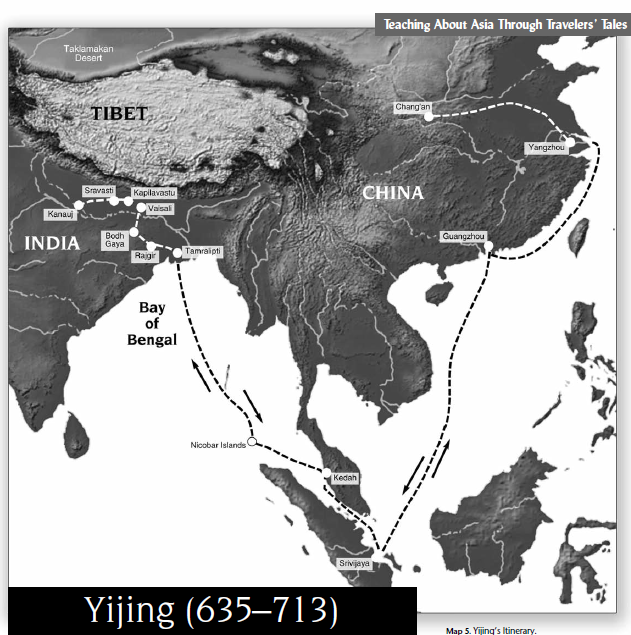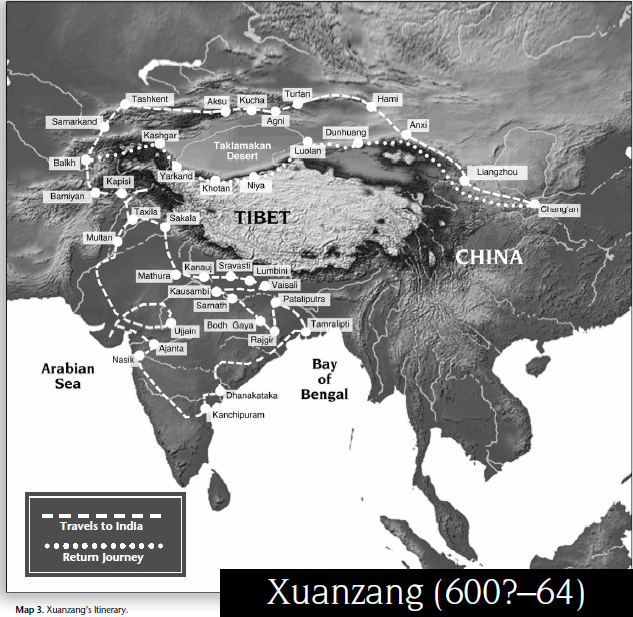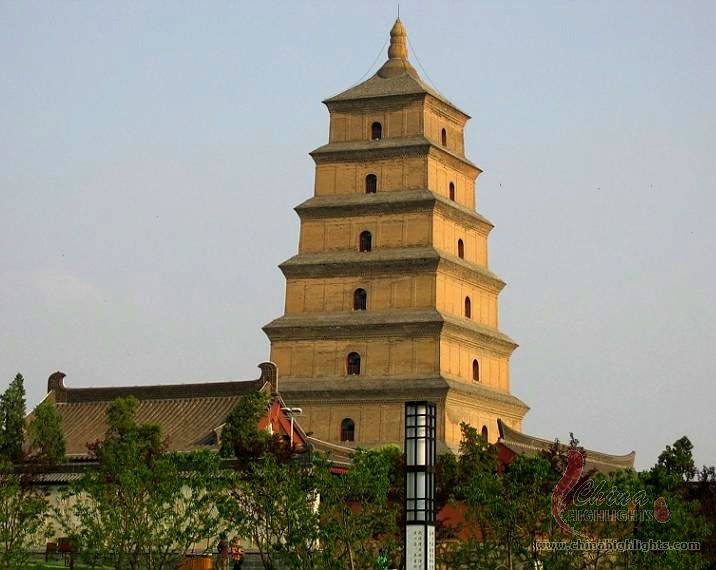It looks like you're using an Ad Blocker.
Please white-list or disable AboveTopSecret.com in your ad-blocking tool.
Thank you.
Some features of ATS will be disabled while you continue to use an ad-blocker.
13
share:
The link below is to three of the most influential Chinese pilgrims who journeyed to India in search of Buddhist manuscripts
Yijing was a Tang Dynasty Chinese Buddhist monk, originally named Zhang Wenming who lived around 650 ro 725 AD
He decided to visit the Buddhist university of Nālandā, in Bihar, India, to further his study Buddhism. Traveling by a Persian boat out of Guangzhou, he arrived in Srivijaya know today as Palembang, Sumatra , Indonesia, where he learned Sanskrit grammar and the Malay language.

Xuanzang was a Chinese Buddhist monk, scholar, traveler, and translator who travelled thru China and India in the early Tang Dynasty. Born in Henan province of China in circa 600 AD

He is noted for building the Great Goose pagoda
Wild Goose Pagoda

Faxian was a Chinese Buddhist monk who travelled by foot all the way from China to India, visiting many sacred Buddhist sites in what are now Xinjiang, China, Pakistan, India, Nepal, and Sri Lanka and between around 400 AD to acquire Buddhist scriptures.

And overview of these gentlemen is in the following PDF
The Chinese Pilgrims
Yijing was a Tang Dynasty Chinese Buddhist monk, originally named Zhang Wenming who lived around 650 ro 725 AD
He decided to visit the Buddhist university of Nālandā, in Bihar, India, to further his study Buddhism. Traveling by a Persian boat out of Guangzhou, he arrived in Srivijaya know today as Palembang, Sumatra , Indonesia, where he learned Sanskrit grammar and the Malay language.
He went on to record visits to the nations of Malayu and Kiteh (Kedah), and in 673 after ten days additional travel reached the "naked kingdom" (south west of Shu). Yijing recorded his impression of the "Kunlun peoples", using an ancient Chinese word for Malay peoples. "Kunlun people have curly hair, dark bodies, bare feet and wear sarongs." He then arrived at the East coast of India, where he met a senior monk and stayed a year to study Sanskrit. Both later followed a group of merchants and visited 30 other principalities. Halfway to Nālandā, Yijing fell sick and was unable to walk; gradually he was left behind by the group. He was looted by bandits and stripped naked. He heard the natives would catch white skins to offer sacrifice to the gods, so he jumped into mud and used leaves to cover his lower body; he walked slowly to Nālandā where he stayed for 11 years.

Xuanzang was a Chinese Buddhist monk, scholar, traveler, and translator who travelled thru China and India in the early Tang Dynasty. Born in Henan province of China in circa 600 AD

He is noted for building the Great Goose pagoda
Wild Goose Pagoda

Faxian was a Chinese Buddhist monk who travelled by foot all the way from China to India, visiting many sacred Buddhist sites in what are now Xinjiang, China, Pakistan, India, Nepal, and Sri Lanka and between around 400 AD to acquire Buddhist scriptures.

And overview of these gentlemen is in the following PDF
The Chinese Pilgrims
Thanks for making this post. History is the most interesting subject because it contains all other subjects.
Lately I have been scouring info about Indian and Chinese histories, it is quite fascinating and equally as entertaining and informative as European or African or American history.
Now that you have given me some solid reading material I will proceed to absorb.
Lately I have been scouring info about Indian and Chinese histories, it is quite fascinating and equally as entertaining and informative as European or African or American history.
Now that you have given me some solid reading material I will proceed to absorb.
reply to post by Hanslune
S & F
I've always wondered why they didn't just go through what is now known as modern day Burma, Nepal, Bangladesh or Bhutan?
Instead of circumnavigating the desert and sailing all the way around to almost the same exact spot?
S & F
I've always wondered why they didn't just go through what is now known as modern day Burma, Nepal, Bangladesh or Bhutan?
Instead of circumnavigating the desert and sailing all the way around to almost the same exact spot?
Originally posted by SLAYER69
reply to post by Hanslune
S & F
I've always wondered why they didn't just go through what is now known as modern day Burma, Nepal, Bangladesh or Bhutan?
Instead of circumnavigating the desert and sailing all the way around to almost the same exact spot?
Thanks Slayer
The terrain there is horrendous. I spend a lot of time in Nepal and travel there would be extremely difficult without modern infrastructure as noted by all traveller's narratives in the 17th to early 20th century. Travel in the Himalayas is difficult and the area to the East of it is a jungled and what my uncle called 'chopped rocks and ridges with a topping of trees'
edit on 6/11/12 by Hanslune because: (no reason given)
There were many other pilgrims between China and India and probably many more that were not recorded or will killed along the way
Link to a wiki page listing some of those who did so or acted as missionaries
Link to a wiki page listing some of those who did so or acted as missionaries
Originally posted by SLAYER69
reply to post by Hanslune
S & F
I've always wondered why they didn't just go through what is now known as modern day Burma, Nepal, Bangladesh or Bhutan?
Instead of circumnavigating the desert and sailing all the way around to almost the same exact spot?
Like Hans said jungles and mountains, some of the most inhospitable jungles and thousand miles of mountains, or a sketchy trip down a river.
Also some of people on that way weren't the friendlyist either and the Chinese emperors made a few enemies along thier borders.
On the other hand ,even though it looks like the hard way the overland route follows a several millenia old trade route. I bet in its heyday the silk road was a very busy trail, there were known water sources and settlements all along the way. The climate is also better its dry and cooler than a festering jungle.
It's still a mighty walk
The sea route is also a well established route with stops in port every few days for water and food.
Amazing journeys especially by foot. There must have been a fair amount of communication between India and China for them to pursue such a long
journey to obtain scriptures. How did they finance their journeys? Now that you have interested me I guess I will have to do some research.
reply to post by grayeagle
Interesting question I don't know true Buddhist monks live by the begging bowl but they may have had patrons
Interesting question I don't know true Buddhist monks live by the begging bowl but they may have had patrons
reply to post by grayeagle
The ascetic lifestyle of a bhuddist monk doesn't require funding. And in many if not all bhuddist cultures it is a social duty to be charitable to a man of the cloth. All a monk required was his robes, sandals, then again maybe not, your small burden bag and your bowl. Charity from strangers, intermittent abbeys and monasteries, along with living off of the land would get you quite some distance.
One thing that I have learned from my limited travels to some very remote and lightly populated areas, is that when life is very hard and people few between , you will find that people are generally very hospitabl, because your very life might hang on someone else's hospitality. I've experienced this in baja and in some very remote area of the US, where complete strangers will welcome you to thier house and offer up what they have even when its very little.
It also reminds me of a story about a '49er, who left upstate New York and pushed a wheel barrow all the way to California, in 8 months, or an Australian surfer kid several years ago who circumnavigated the entire continent of, Africa, all but the most inhospitable or dangerous areas, with only his surf board and a day pack.
The ascetic lifestyle of a bhuddist monk doesn't require funding. And in many if not all bhuddist cultures it is a social duty to be charitable to a man of the cloth. All a monk required was his robes, sandals, then again maybe not, your small burden bag and your bowl. Charity from strangers, intermittent abbeys and monasteries, along with living off of the land would get you quite some distance.
One thing that I have learned from my limited travels to some very remote and lightly populated areas, is that when life is very hard and people few between , you will find that people are generally very hospitabl, because your very life might hang on someone else's hospitality. I've experienced this in baja and in some very remote area of the US, where complete strangers will welcome you to thier house and offer up what they have even when its very little.
It also reminds me of a story about a '49er, who left upstate New York and pushed a wheel barrow all the way to California, in 8 months, or an Australian surfer kid several years ago who circumnavigated the entire continent of, Africa, all but the most inhospitable or dangerous areas, with only his surf board and a day pack.
edit on 8-11-2012 by punkinworks10 because: (no reason given)
reply to post by punkinworks10
Hey Punkinworks10
Couldn't agree more. I've take four long walks in my time, one for two weeks in Nepal, once in India around Simla and later around the Indo-Roman port of Arikamedu and another along the coast of southern Turkey. I found the people, especially the farmers quite helpful, the bureaucracy unhelpful! I'd say the people of Nepal were the best, Gurung and Sherpa - with special mention of the Tibetan people living in Nepal the Lhomi and Dolpo (at different times)
Hey Punkinworks10
Couldn't agree more. I've take four long walks in my time, one for two weeks in Nepal, once in India around Simla and later around the Indo-Roman port of Arikamedu and another along the coast of southern Turkey. I found the people, especially the farmers quite helpful, the bureaucracy unhelpful! I'd say the people of Nepal were the best, Gurung and Sherpa - with special mention of the Tibetan people living in Nepal the Lhomi and Dolpo (at different times)
reply to post by Hanslune
Hey there Hans ,
Those are some pretty good treks, would love to have had an experience like that.
Hey there Hans ,
Those are some pretty good treks, would love to have had an experience like that.
reply to post by punkinworks10
They are good memories but both times in India I had to end them early due to the onset of Nana Sahib's revenge. I'm planning to do a part of the PCT next summer, not quite Nepal but easier to get to
They are good memories but both times in India I had to end them early due to the onset of Nana Sahib's revenge. I'm planning to do a part of the PCT next summer, not quite Nepal but easier to get to
edit on 9/11/12 by Hanslune because: (no reason given)
reply to post by muzzleflash
Xuen Zang's travelogue has been much discussed except for a small sector of his return journey. He travelled in India, from Kanchipuram in present day Tamil Nadu to Bharoch in Gujarat through Maharashtra. He does not give much details of the places where he stayed. Here are some links, where this travel through this sector has been discussed
Part I
Part II
Part III
Xuen Zang's travelogue has been much discussed except for a small sector of his return journey. He travelled in India, from Kanchipuram in present day Tamil Nadu to Bharoch in Gujarat through Maharashtra. He does not give much details of the places where he stayed. Here are some links, where this travel through this sector has been discussed
Part I
Part II
Part III
new topics
-
Intro once again
Introductions: 1 hours ago -
University student disciplined after saying veganism is wrong and gender fluidity is stupid
Education and Media: 2 hours ago -
Geddy Lee in Conversation with Alex Lifeson - My Effin’ Life
People: 3 hours ago -
God lived as a Devil Dog.
Short Stories: 3 hours ago -
Police clash with St George’s Day protesters at central London rally
Social Issues and Civil Unrest: 5 hours ago -
TLDR post about ATS and why I love it and hope we all stay together somewhere
General Chit Chat: 6 hours ago -
Hate makes for strange bedfellows
US Political Madness: 8 hours ago -
Who guards the guards
US Political Madness: 11 hours ago
top topics
-
Hate makes for strange bedfellows
US Political Madness: 8 hours ago, 16 flags -
Who guards the guards
US Political Madness: 11 hours ago, 13 flags -
whistleblower Captain Bill Uhouse on the Kingman UFO recovery
Aliens and UFOs: 17 hours ago, 12 flags -
Police clash with St George’s Day protesters at central London rally
Social Issues and Civil Unrest: 5 hours ago, 8 flags -
TLDR post about ATS and why I love it and hope we all stay together somewhere
General Chit Chat: 6 hours ago, 5 flags -
University student disciplined after saying veganism is wrong and gender fluidity is stupid
Education and Media: 2 hours ago, 5 flags -
Has Tesla manipulated data logs to cover up auto pilot crash?
Automotive Discussion: 12 hours ago, 2 flags -
God lived as a Devil Dog.
Short Stories: 3 hours ago, 2 flags -
Geddy Lee in Conversation with Alex Lifeson - My Effin’ Life
People: 3 hours ago, 2 flags -
Intro once again
Introductions: 1 hours ago, 2 flags
active topics
-
"We're All Hamas" Heard at Columbia University Protests
Social Issues and Civil Unrest • 250 • : TheWoker -
Candidate TRUMP Now Has Crazy Judge JUAN MERCHAN After Him - The Stormy Daniels Hush-Money Case.
Political Conspiracies • 733 • : Annee -
Deadpool and Wolverine
Movies • 5 • : WhitewaterSquirrel -
University student disciplined after saying veganism is wrong and gender fluidity is stupid
Education and Media • 12 • : HatesFreshAir -
-@TH3WH17ERABB17- -Q- ---TIME TO SHOW THE WORLD--- -Part- --44--
Dissecting Disinformation • 629 • : fringeofthefringe -
Terrifying Encounters With The Black Eyed Kids
Paranormal Studies • 63 • : Consvoli -
TLDR post about ATS and why I love it and hope we all stay together somewhere
General Chit Chat • 7 • : Consvoli -
Mood Music Part VI
Music • 3089 • : TheWoker -
Intro once again
Introductions • 1 • : Encia22 -
Hate makes for strange bedfellows
US Political Madness • 33 • : DBCowboy
13
